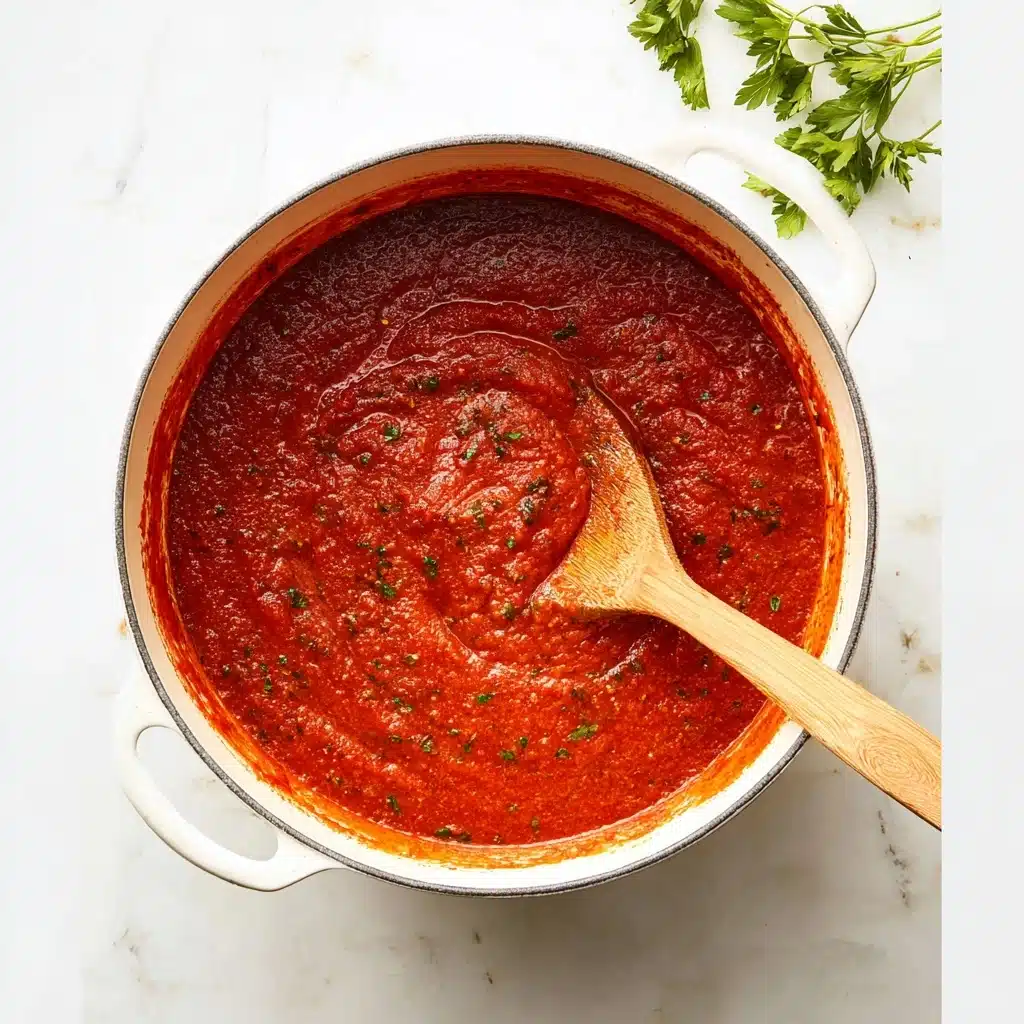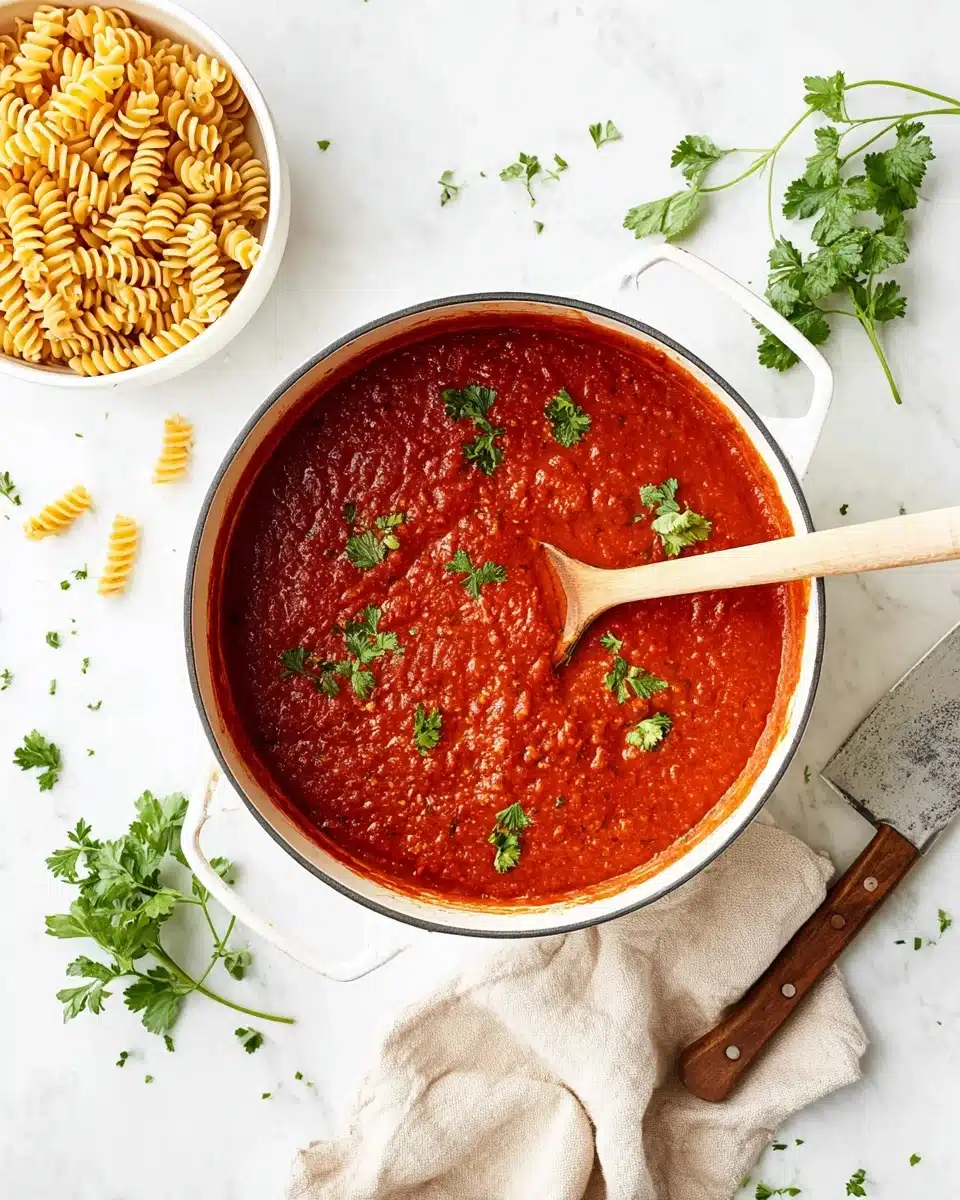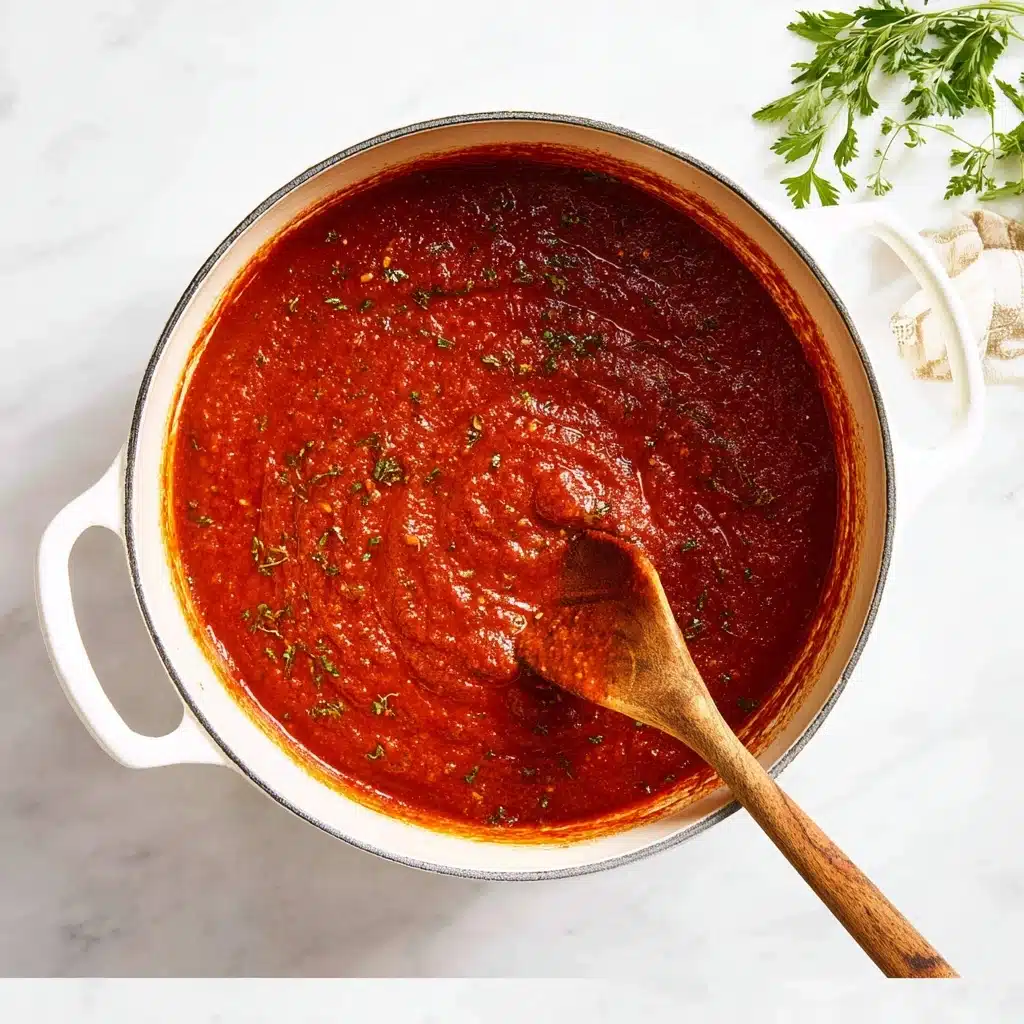If there’s one recipe I always turn to when I’m craving something comforting and vibrant, it’s How to Make Homemade Marinara Sauce. This classic Italian staple is so much more than just a pasta companion – it’s a celebration of sweet tomatoes, aromatic garlic, and herbs that effortlessly come together in a bubbling pot. Once you master this simple sauce, you’ll see just how transformative a jar of marinara can be, whether you’re tossing it with spaghetti, spooning it over pizza, or dipping warm bread into its rich depths.
Ingredients You’ll Need
The beauty of How to Make Homemade Marinara Sauce is that it relies on just a handful of pantry essentials. Each ingredient plays a key role, from the brightness of tomatoes to the subtle depth that fresh herbs and olive oil add. Here’s what you’ll need, plus a tip for getting the most out of every addition:
- Canned whole tomatoes: These give the sauce body and sweetness; San Marzano tomatoes are especially prized for their rich, balanced flavor.
- Good quality olive oil: Don’t skimp here, a flavorful olive oil creates the sauce’s silky texture and carries the aromatics beautifully.
- Fresh garlic: Sliced or finely minced, it brings out a pungent, mouthwatering aroma and taste – cook it gently so it never burns.
- Yellow onion: Finely chopped, it adds mellow sweetness and depth without overwhelming the tomato flavor.
- Crushed red pepper flakes: Just a pinch wakes up the sauce with gentle heat; adjust to your spice preference.
- Sea salt: Essential for balancing acidity and bringing out each flavor’s best.
- Fresh basil: Torn just before stirring in, basil lifts the sauce with brightness and classic Italian fragrance.
- Sugar (optional): If your tomatoes are particularly acidic, a half teaspoon of sugar can round everything out.
How to Make How to Make Homemade Marinara Sauce
Step 1: Sauté Aromatics
Start by gently heating the olive oil in a large saucepan over medium heat. Add the chopped onion and let it soften, releasing its sweetness without letting it brown. Stir in the minced garlic and cook just until fragrant. This early step is crucial – it’s how you build the savory backbone that the whole sauce rests upon!
Step 2: Add Tomatoes and Simmer
Pour in the whole canned tomatoes, crushing them with your hands right over the pan (it’s truly the most satisfying part), or use a spoon. Season with salt and a touch of red pepper flakes. Bring the mixture to a gentle simmer, cover loosely, and let it burble away for at least 30 minutes. The magic happens as the tomatoes reduce and their flavors concentrate. If you like your marinara smoother, use an immersion blender right in the pot or pass it through a food mill.
Step 3: Taste and Adjust
Now’s the time to taste your sauce. Is there enough salt? Too much acidity? Add a pinch of sugar if needed to mellow things out. Stir in the fresh basil, torn into pieces for maximum aroma, and let it wilt right into the sauce. Simmer for another five minutes to bring all the flavors together, then remove from heat.
Step 4: Finish and Serve
Ladle your glossy marinara into a big bowl or straight onto hot pasta. A swirl of extra olive oil or more torn basil on top is always welcome. That’s all there is to mastering How to Make Homemade Marinara Sauce – from pantry staples to pure Italian comfort in just under an hour.
How to Serve How to Make Homemade Marinara Sauce

Garnishes
A finishing touch goes a long way! I love a shower of freshly grated Parmigiano-Reggiano or pecorino, a handful of chopped basil, or a spark of cracked black pepper over my marinara. If you’re feeling bold, try a sprinkle of lemon zest or a few oil-cured olives for even more dimension.
Side Dishes
This sauce begs for something to soak it up: tear off chunks of crusty, warm Italian bread or pair it with soft garlic knots. A crisp, peppery arugula salad with a simple lemon vinaigrette makes a bright, fresh counterpoint to the sauce’s richness. Don’t forget a glass of red wine if the mood strikes!
Creative Ways to Present
Go way beyond spaghetti: layer your marinara in lasagna, spoon it over grilled chicken, or use it as the perfect dip for fried mozzarella sticks. It’s also fantastic as a pizza base, or swirled through creamy polenta. You’ll soon discover that learning How to Make Homemade Marinara Sauce opens up endless ways to bring Italian flavor to your favorite meals.
Make Ahead and Storage
Storing Leftovers
Allow the sauce to cool completely before transferring to an airtight container. It will keep beautifully in the refrigerator for up to five days, ready to brighten lunches and fast weeknight dinners. The flavors actually deepen with time, so don’t hesitate to make a double batch.
Freezing
Marinara sauce freezes incredibly well. Divide the cooled sauce into freezer-safe bags or containers, leaving a little room for expansion. Freeze for up to three months; just thaw overnight in the fridge or under running cold water for a quick dinner solution.
Reheating
Warm the sauce gently over low heat, stirring occasionally, until heated through. If you notice it’s thickened in the fridge or freezer, add a splash of water or broth to loosen it up to your preferred consistency. The aroma will instantly fill your kitchen all over again!
FAQs
Can I use fresh tomatoes instead of canned?
Absolutely! If tomatoes are in season, substitute peeled and chopped ripe tomatoes for canned. You may need to simmer the sauce a bit longer to evaporate the extra water and develop that familiar, concentrated flavor.
What kind of onion works best?
Yellow onion is my top pick for its gentle sweetness, but white or even sweet Vidalia onions can also shine. Just be sure to sauté them until completely soft for the best texture in your marinara.
How can I make the sauce smoother or chunkier?
After simmering, you can use a potato masher for a chunkier texture or blitz the sauce with an immersion blender for a silkier finish. It’s all up to your personal preference!
Is How to Make Homemade Marinara Sauce gluten-free?
Yes, the sauce itself contains no gluten whatsoever. Just be mindful of what you serve it with and always double-check any store-bought components like broth for hidden gluten, if you’re highly sensitive.
Can I add other herbs or spices?
Absolutely! While basil is classic, a pinch of oregano or thyme, or a bay leaf (removed before serving), can add lovely complexity. Play around to find your signature house marinara.
Final Thoughts
If you’ve never tried to make this from scratch before, you’ll be genuinely amazed at how easy and rewarding it is to learn How to Make Homemade Marinara Sauce. With just a few simple ingredients and a little time, you create something totally soul-soothing and impressively versatile. Give it a go – I bet this will become your new favorite kitchen staple!
PrintMushroom Ravioli With Parmesan Cream Sauce Recipe
Learn how to make a flavorful and versatile homemade marinara sauce that is perfect for pasta, pizzas, and more. This classic recipe is simple to prepare and bursting with fresh tomato and herb flavors.
- Prep Time: 10 minutes
- Cook Time: 30 minutes
- Total Time: 40 minutes
- Yield: Makes about 4 cups 1x
- Category: Sauce
- Method: Stovetop
- Cuisine: Italian
- Diet: Vegetarian
Ingredients
Ingredients:
- 2 tbsp olive oil
- 1 onion, finely chopped
- 4 garlic cloves, minced
- 1 can (28 oz) crushed tomatoes
- 1 can (14 oz) tomato sauce
- 1/4 cup fresh basil, chopped
- 1/4 cup fresh parsley, chopped
- 1 tsp sugar
- Salt and pepper to taste
Instructions
- Saute Aromatics: In a large saucepan, heat olive oil over medium heat. Add onions and garlic, sauté until softened.
- Add Tomatoes: Pour in crushed tomatoes and tomato sauce. Stir well.
- Season: Add basil, parsley, sugar, salt, and pepper. Simmer for 30 minutes, stirring occasionally.
- Blend: Use an immersion blender to puree the sauce until smooth.
- Serve: Use immediately or let the sauce cool before storing in airtight containers.
Notes
- You can customize the sauce by adding red pepper flakes for heat or a splash of red wine for depth of flavor.
- This sauce freezes well, so make a big batch and store in portions for later use.
Nutrition
- Serving Size: 1/2 cup
- Calories: 80
- Sugar: 5g
- Sodium: 480mg
- Fat: 4g
- Saturated Fat: 0.5g
- Unsaturated Fat: 2.5g
- Trans Fat: 0g
- Carbohydrates: 10g
- Fiber: 3g
- Protein: 2g
- Cholesterol: 0mg




